PEUGEOT PARTNER TEPEE ELECTRIC 2017 Manual Online
Manufacturer: PEUGEOT, Model Year: 2017, Model line: PARTNER TEPEE ELECTRIC, Model: PEUGEOT PARTNER TEPEE ELECTRIC 2017Pages: 252, PDF Size: 9.89 MB
Page 81 of 252
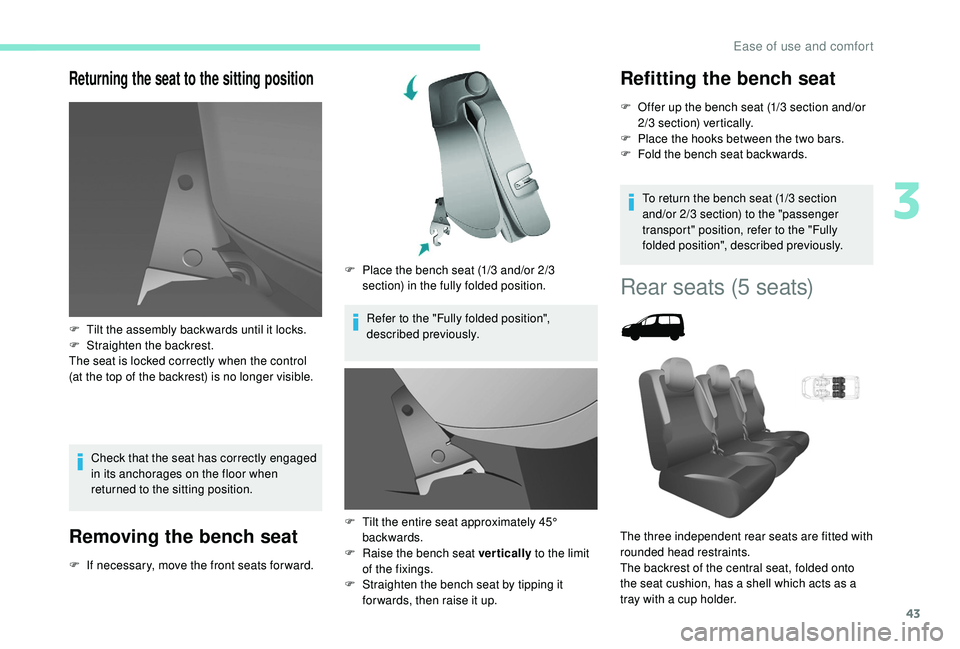
43
Returning the seat to the sitting position
Check that the seat has correctly engaged
in its anchorages on the floor when
returned to the sitting position.
Removing the bench seat
F If necessary, move the front seats for ward.F
P
lace the bench seat (1/3 and/or 2/3
section) in the fully folded position.
Refer to the "Fully folded position",
described previously.
F
T
ilt the assembly backwards until it locks.
F
S
traighten the backrest.
The seat is locked correctly when the control
(at the top of the backrest) is no longer visible.
F
T
ilt the entire seat approximately 45°
backwards.
F Ra ise the bench seat vertically
to the limit
of the fixings.
F
S
traighten the bench seat by tipping it
for wards, then raise it up.
Refitting the bench seat
F Offer up the bench seat (1/3 section and/or 2/3 section) vertically.
F
P
lace the hooks between the two bars.
F
F
old the bench seat backwards.
To return the bench seat (1/3 section
and/or 2/3 section) to the "passenger
transport" position, refer to the "Fully
folded position", described previously.
Rear seats (5 seats)
The three independent rear seats are fitted with
rounded head restraints.
The backrest of the central seat, folded onto
the seat cushion, has a shell which acts as a
tray with a cup holder.
3
Ease of use and comfort
Page 82 of 252
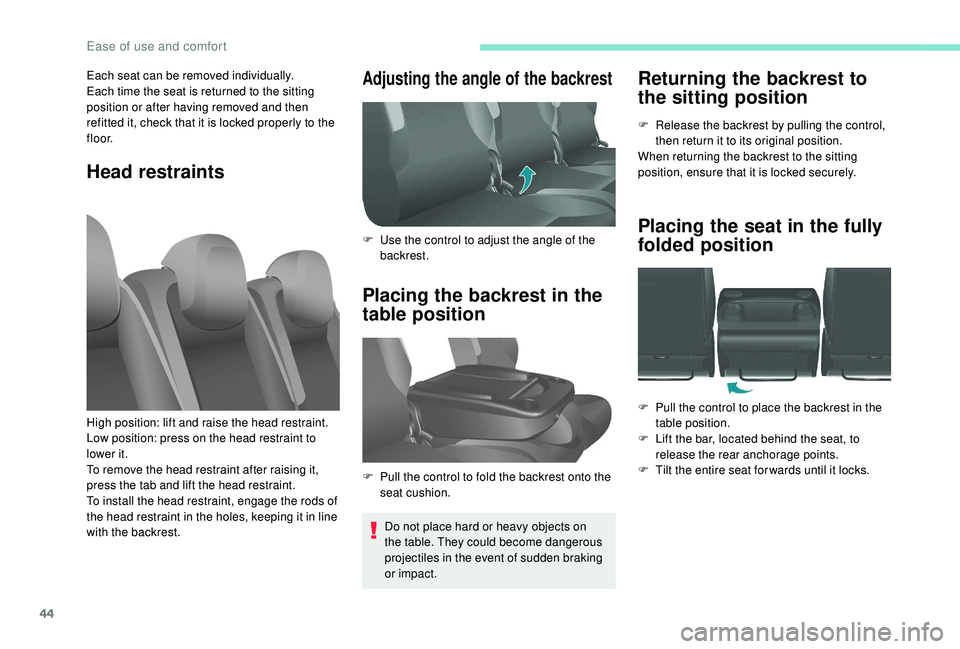
44
Returning the backrest to
the sitting position
F Release the backrest by pulling the control, then return it to its original position.
When returning the backrest to the sitting
position, ensure that it is locked securely.
Placing the seat in the fully
folded position
F Pull the control to place the backrest in the table position.
F
L
ift the bar, located behind the seat, to
release the rear anchorage points.
F
T
ilt the entire seat for wards until it locks.
Each seat can be removed individually.
Each time the seat is returned to the sitting
position or after having removed and then
refitted it, check that it is locked properly to the
f l o o r.
Head restraints
Adjusting the angle of the backrest
High position: lift and raise the head restraint.
Low position: press on the head restraint to
lower it.
To remove the head restraint after raising it,
press the tab and lift the head restraint.
To install the head restraint, engage the rods of
the head restraint in the holes, keeping it in line
with the backrest.
F
U
se the control to adjust the angle of the
backrest.
Placing the backrest in the
table position
F Pull the control to fold the backrest onto the seat cushion.
Do not place hard or heavy objects on
the table. They could become dangerous
projectiles in the event of sudden braking
or impact.
Ease of use and comfort
Page 83 of 252
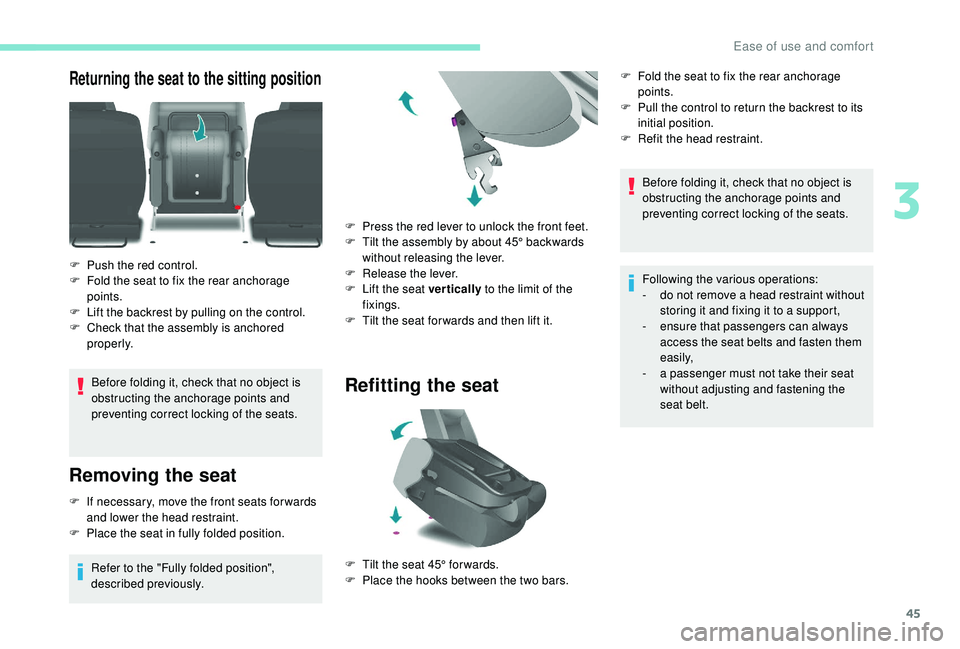
45
Returning the seat to the sitting position
Before folding it, check that no object is
obstructing the anchorage points and
preventing correct locking of the seats.
Removing the seat
F If necessary, move the front seats for wards and lower the head restraint.
F
P
lace the seat in fully folded position.
Refer to the "Fully folded position",
described previously. F
P
ress the red lever to unlock the front feet.
F
T
ilt the assembly by about 45° backwards
without releasing the lever.
F
R
elease the lever.
F
L
ift the seat vertically
to the limit of the
fixings.
F
T
ilt the seat for wards and then lift it.
Refitting the seat
F Push the red control.
F
F old the seat to fix the rear anchorage
points.
F
L
ift the backrest by pulling on the control.
F
C
heck that the assembly is anchored
properly.
F
T
ilt the seat 45° for wards.
F
P
lace the hooks between the two bars.Before folding it, check that no object is
obstructing the anchorage points and
preventing correct locking of the seats.
Following the various operations:
-
d
o not remove a head restraint without
storing it and fixing it to a support,
-
e
nsure that passengers can always
access the seat belts and fasten them
easily,
-
a p
assenger must not take their seat
without adjusting and fastening the
seat belt.
F
F
old the seat to fix the rear anchorage
points.
F
P
ull the control to return the backrest to its
initial position.
F
R
efit the head restraint.
3
Ease of use and comfort
Page 84 of 252
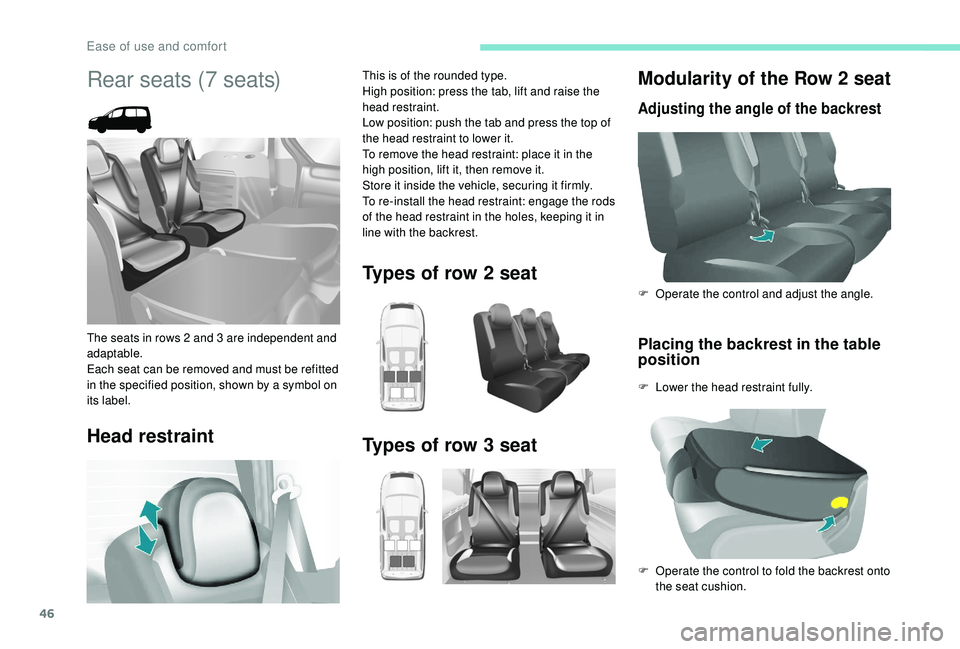
46
Modularity of the Row 2 seat
Adjusting the angle of the backrest
Placing the backrest in the table
position
F Lower the head restraint fully. F
O
perate the control and adjust the angle.
F
O
perate the control to fold the backrest onto
the seat cushion.
Rear seats (7 seats)
The seats in rows 2 and 3 are independent and
adaptable.
Each seat can be removed and must be refitted
in the specified position, shown by a symbol on
its label.
Head restraint
This is of the rounded type.
High position: press the tab, lift and raise the
head restraint.
Low position: push the tab and press the top of
the head restraint to lower it.
To remove the head restraint: place it in the
high position, lift it, then remove it.
Store it inside the vehicle, securing it firmly.
To re-install the head restraint: engage the rods
of the head restraint in the holes, keeping it in
line with the backrest.
Types of row 2 seat
Types of row 3 seat
Ease of use and comfort
Page 85 of 252
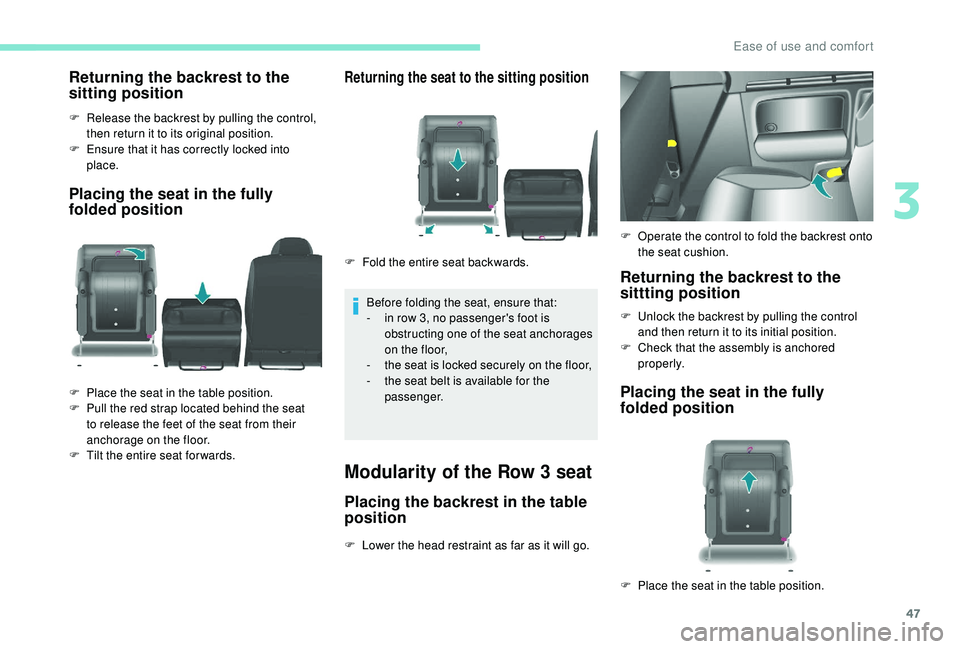
47
Returning the backrest to the
sitting position
F Release the backrest by pulling the control, then return it to its original position.
F
E
nsure that it has correctly locked into
place.
Placing the seat in the fully
folded position
Returning the seat to the sitting position
Before folding the seat, ensure that:
- i n row 3, no passenger's foot is
obstructing one of the seat anchorages
on the floor,
-
t
he seat is locked securely on the floor,
-
t
he seat belt is available for the
passenger.
Modularity of the Row 3 seat
Placing the backrest in the table
position
F Lower the head restraint as far as it will go.
F
P
lace the seat in the table position.
F
P
ull the red strap located behind the seat
to release the feet of the seat from their
anchorage on the floor.
F
T
ilt the entire seat for wards. F
F
old the entire seat backwards.
Returning the backrest to the
sittting position
F Unlock the backrest by pulling the control
and then return it to its initial position.
F
C
heck that the assembly is anchored
properly.
Placing the seat in the fully
folded position
F Operate the control to fold the backrest onto the seat cushion.
F
P
lace the seat in the table position.
3
Ease of use and comfort
Page 86 of 252
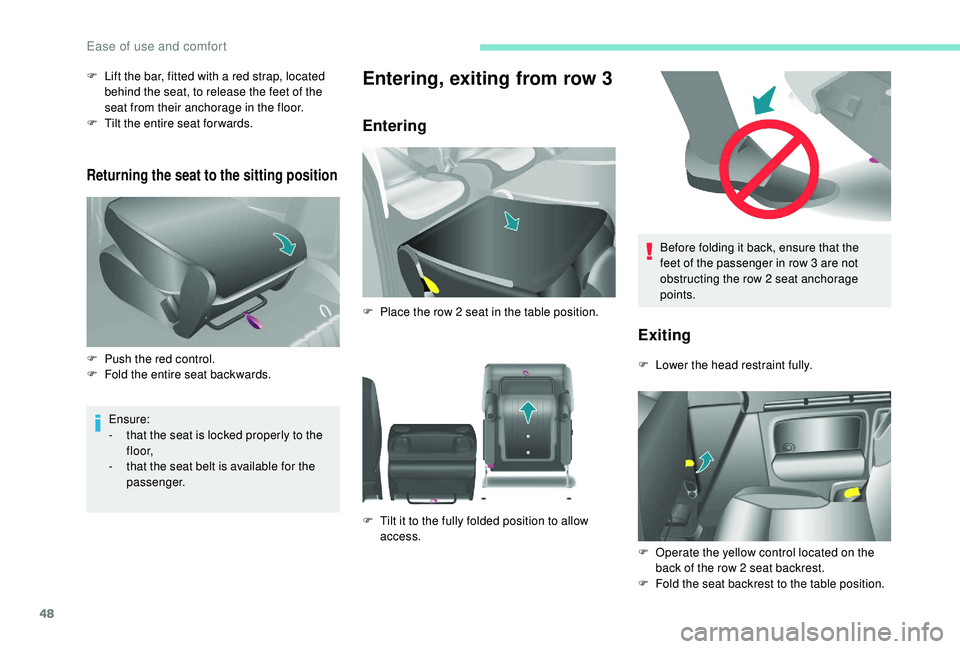
48
Before folding it back, ensure that the
feet of the passenger in row 3 are not
obstructing the row 2 seat anchorage
points.
Exiting
F Lower the head restraint fully.
F
O
perate the yellow control located on the
back of the row 2 seat backrest.
F
F
old the seat backrest to the table position.
Returning the seat to the sitting position
Ensure:
- t hat the seat is locked properly to the
f l o o r,
-
t
hat the seat belt is available for the
passenger.
Entering, exiting from row 3
Entering
F Lift the bar, fitted with a red strap, located behind the seat, to release the feet of the
seat from their anchorage in the floor.
F
T
ilt the entire seat for wards.
F
P
ush the red control.
F
F
old the entire seat backwards. F
P
lace the row 2 seat in the table position.
F
T
ilt it to the fully folded position to allow
access.
Ease of use and comfort
Page 87 of 252
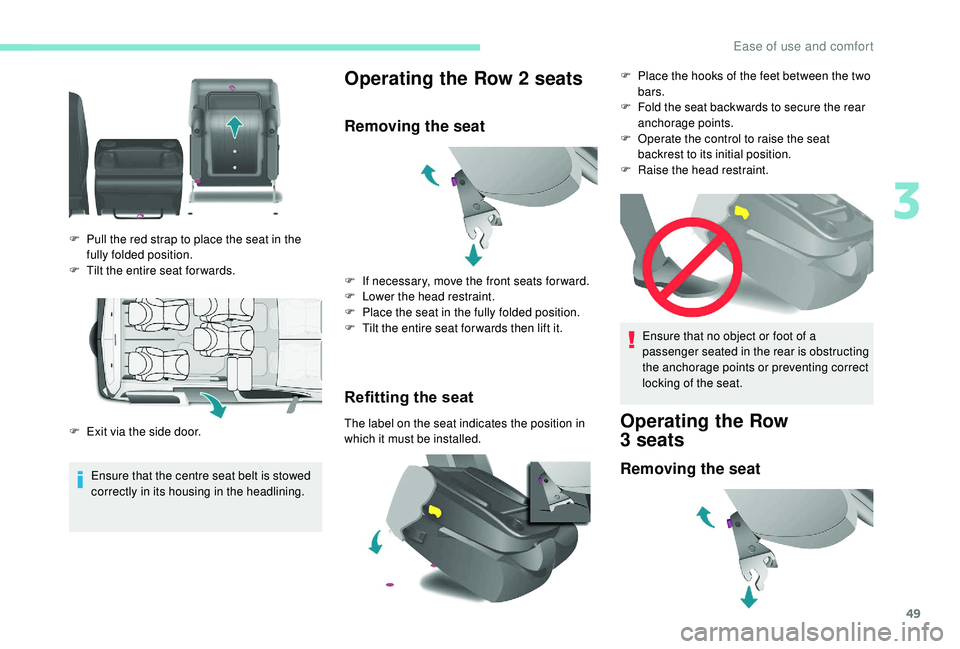
49
Ensure that the centre seat belt is stowed
correctly in its housing in the headlining.
Operating the Row 2 seats
Removing the seat
Refitting the seat
The label on the seat indicates the position in
which it must be installed.
F
P
ull the red strap to place the seat in the
fully folded position.
F
T
ilt the entire seat for wards.
F
E
xit via the side door. F
I
f necessary, move the front seats for ward.
F
L
ower the head restraint.
F
P
lace the seat in the fully folded position.
F
T
ilt the entire seat for wards then lift it.
Ensure that no object or foot of a
passenger seated in the rear is obstructing
the anchorage points or preventing correct
locking of the seat.Operating the Row
3 seats
Removing the seat
F Place the hooks of the feet between the two
bars.
F
F
old the seat backwards to secure the rear
anchorage points.
F
O
perate the control to raise the seat
backrest to its initial position.
F
Ra
ise the head restraint.
3
Ease of use and comfort
Page 88 of 252
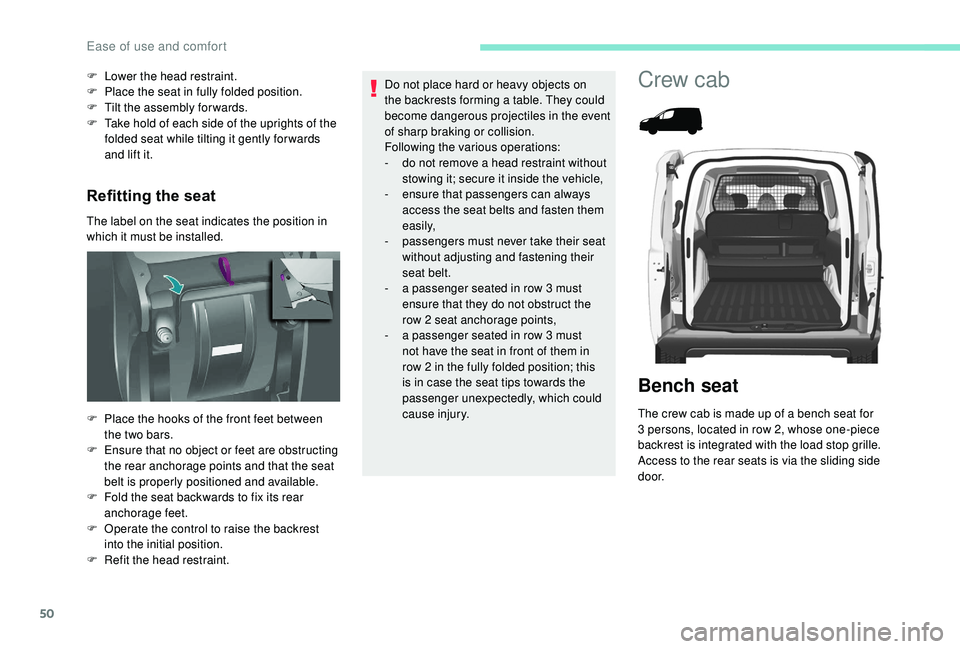
50
Refitting the seat
The label on the seat indicates the position in
which it must be installed. F
L
ower the head restraint.
F
P
lace the seat in fully folded position.
F
T
ilt the assembly forwards.
F
T
ake hold of each side of the uprights of the
folded seat while tilting it gently for wards
and lift it.
F
P
lace the hooks of the front feet between
the two bars.
F
E
nsure that no object or feet are obstructing
the rear anchorage points and that the seat
belt is properly positioned and available.
F
F
old the seat backwards to fix its rear
anchorage feet.
F
O
perate the control to raise the backrest
into the initial position.
F
R
efit the head restraint. Do not place hard or heavy objects on
the backrests forming a table. They could
become dangerous projectiles in the event
of sharp braking or collision.
Following the various operations:
-
d
o not remove a head restraint without
stowing it; secure it inside the vehicle,
-
e
nsure that passengers can always
access the seat belts and fasten them
easily,
-
p
assengers must never take their seat
without adjusting and fastening their
seat belt.
-
a p
assenger seated in row 3 must
ensure that they do not obstruct the
row 2 seat anchorage points,
-
a p
assenger seated in row 3 must
not have the seat in front of them in
row 2 in the fully folded position; this
is in case the seat tips towards the
passenger unexpectedly, which could
cause injury.
Crew cab
Bench seat
The crew cab is made up of a bench seat for
3 persons, located in row 2, whose one-piece
backrest is integrated with the load stop grille.
Access to the rear seats is via the sliding side
d o o r.
Ease of use and comfort
Page 89 of 252
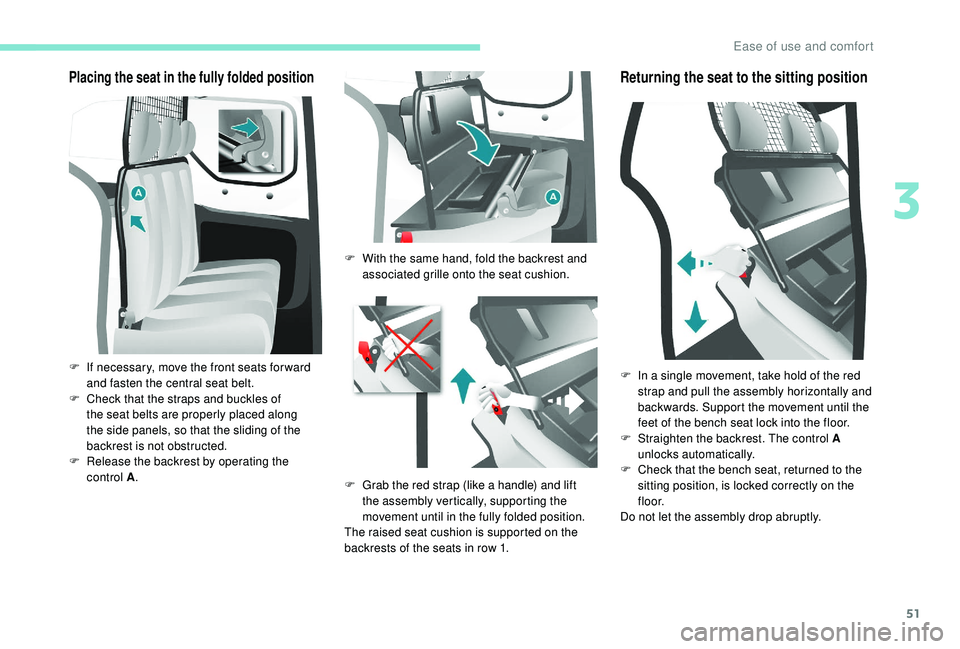
51
Placing the seat in the fully folded position
F If necessary, move the front seats for ward and fasten the central seat belt.
F
C
heck that the straps and buckles of
the seat belts are properly placed along
the side panels, so that the sliding of the
backrest is not obstructed.
F
R
elease the backrest by operating the
control
A. F
W
ith the same hand, fold the backrest and
associated grille onto the seat cushion.
F
G
rab the red strap (like a handle) and lift
the assembly vertically, supporting the
movement until in the fully folded position.
The raised seat cushion is supported on the
backrests of the seats in row 1.
Returning the seat to the sitting position
F In a single movement, take hold of the red strap and pull the assembly horizontally and
backwards. Support the movement until the
feet of the bench seat lock into the floor.
F
S
traighten the backrest. The control A
unlocks automatically.
F
C
heck that the bench seat, returned to the
sitting position, is locked correctly on the
f l o o r.
Do not let the assembly drop abruptly.
3
Ease of use and comfort
Page 90 of 252

52
Seat modularity and configurations
The various operations must be carried
out when stationary.
5-seat configuration
Head restraints and seat
belts
The three seats are equipped with seat belts
with inertia reels. The seat belts of the side
seats are secured on the panels, while the
seat belt of the central seat is secured on the
backrest of the bench seat.
Each seat has a head restraint, screwed to the
load stop grille, which can be removed.
Do not place a head restraint inside the
vehicle without stowing it or securing it to a
support.
Do not drive with rear passengers without
having the head restraints screwed in place.
There is no need to assist, guide or retain
it by the arm that remains free during the
tilting movement.
The rear seat belt fittings are not designed
to secure the load. Use only the stowing
rings on the floor.
The crew cab bench seat is not suitable
for the installation of a child seat.
Ease of use and comfort